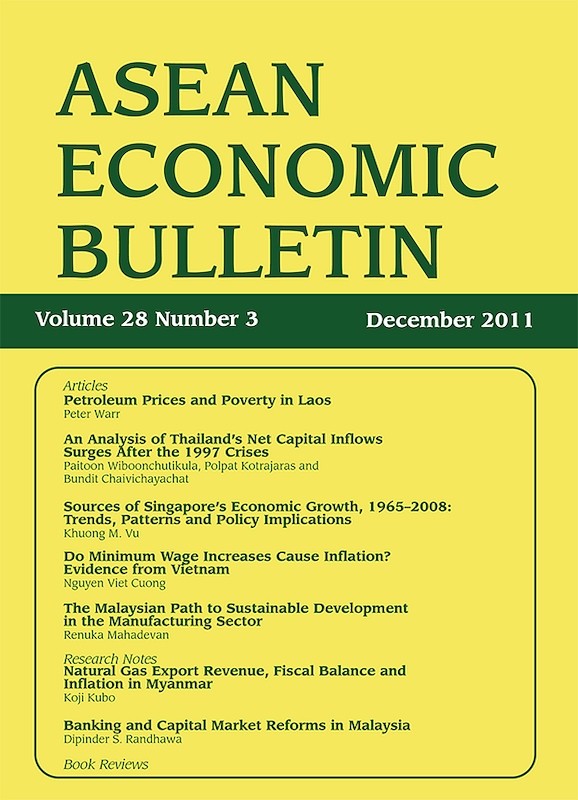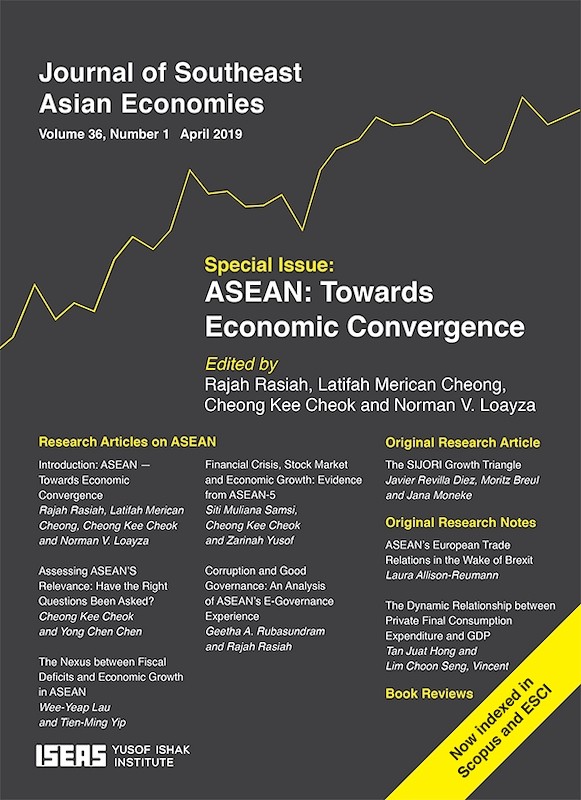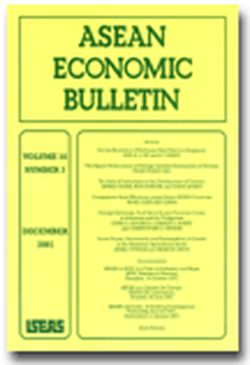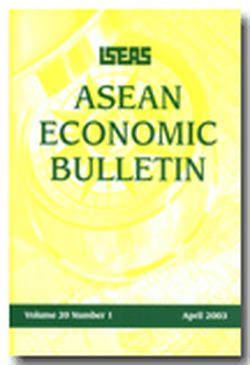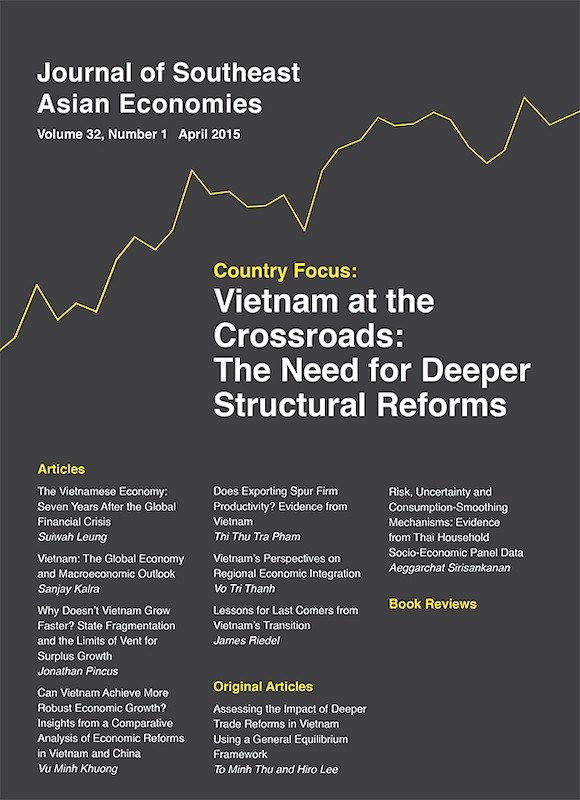Journal of Southeast Asian Economies Vol. 37/2 (Aug 2020)

Date of publication:
August 2020
Publisher:
ISEAS – Yusof Ishak Institute
Number of pages:
132
Code:
AE37/2
About the publication
Contents
-
Journal of Southeast Asian Economies Vol. 37/2 (Aug 2020)
[Whole Publication, ISSN: 23395206] -
Preliminary pages
- RESEARCH ARTICLES
-
1. Indonesian Macro Policy Through Two Crises, by Prayudhi Azwar, Rod Tyers, authors see abstractIndonesia fielded shocks due to the Asian Financial Crisis (AFC) and the Global Financial Crisis (GFC) quite differently. Financial contagion, policy misdirection, panic and political upheaval saw the AFC bring economic collapse. The GFC, however, brought about real domestic growth of 6.1 per cent (2008) and 4.5 per cent (2009)—amongst the world’s best performances at the time. This paper reviews these events and employs numerical modelling of stylized AFC and GFC shocks to show that some of the contrast stems from differences in the shocks and intervening changes in Indonesia’s economic structure. Critically, IMF conditionality during the AFC required unsustainably contractionary reforms. Capital flight elements were present in both crises, however, and exchange rate depreciations and money-financed fiscal expansions are shown to have contributed significantly to resolution.
-
2. The Impact of the US Unconventional Monetary Policy and Its Normalization in the Philippines: A Capital Flow Perspective, by Ivy G Sabuga, Jacinta Bernadette Rico Shirakawa, authors see abstractThis study presents an empirical analysis of the impact of the US unconventional monetary policy and its normalization on the dynamics of relatively volatile capital inflows (i.e., portfolio equity, portfolio debt securities, and bank and money market) into the Philippines using monthly data from January 2008 to March 2016. Results are obtained using a structural vector autoregression (SVAR) model, interacting both “push” and “pull” factors of capital inflows into the SVAR system. Overall, results show that the effects of these US monetary policy shocks on the aforementioned volatile capital inflows are minimal when scaled in terms of gross domestic product (GDP). The findings also suggest that, of the three volatile capital inflows, the impact of these shocks is more pronounced on portfolio debt securities, as well as on bank and money market inflows. Meanwhile, the impact on portfolio equity inflows is very limited. Additionally, the persistence of these shocks is seen to last from one to six months.
-
3. Women in Business and Management in Thailand: Transforming High Participation Without EEO, by Natenapha Wailerdsak (Yabushita), author see abstractThailand has no equal employment opportunity (EEO) laws or mandatory women’s quota system as seen in developed countries. The only exception is a provision in the Thai Constitution that states that men and women shall enjoy equal rights. Despite this, the country has one of the world’s highest number of women in management positions. It is generally held that Thai society has given women the opportunity to progress at the same rate as men within the workplace. Given this background, this paper examines the factors behind the high participation rate of Thai women in business and management without the support of institutional EEO legislation and mandatory state regulation from the supply side. It argues that, as Thailand transforms into a super-aged society, gender equality strategies, particularly non-discriminatory employment opportunities and work-life balance measures, should be consistently provided to ensure sustainable and inclusive growth.
- RESEARCH NOTES
-
4. Labour Migration and Relocation of Apparel Production between Thailand and Myanmar, by Atsuko Mizuno, author see abstractThis paper analyses labour migration and relocation of apparel production between Thailand and Myanmar during the first half of the 2010s. For a long time, unskilled migrant workers allowed labour-intensive industries such as the apparel sector to flourish in Thailand. However, higher costs have gradually decreased the competitiveness of the Thai garment industry, forcing implementation of industrial upgrading measures and relocation of some labour-intensive production to neighbouring countries. Conversely, Myanmar, a major source of migrant workers for Thailand, has increased its apparel exports since 2010. Using empirical evidence, this study reveals that, first, the Thai apparel industry has significantly upgraded while employing foreign workers and second, production networks between the two countries have solidified over the past decade.
-
5. Impact of Exchange Rate and Firm Heterogeneity on Exports: Empirical Evidence from Four ASEAN Economies, by Yizhe Daniel Xie, Youngmin Baek, authors see abstractThis paper examines the impact of currency appreciation and firm heterogeneity on exports from ASEAN, which appears to have the potential to replicate China’s export-driven growth miracle. It tries to fill the gap in literature related to exchange rate fluctuations and firm heterogeneity in Southeast Asia, specifically focusing on the “zero-trade” problem. Four main findings emerge from this study. First, contrary to conventional wisdom, exchange rate appreciation does, in fact, discourage exports by ASEAN-based companies. Second, firm responses to currency appreciation vary significantly. While SMEs and first-time exporters are more sensitive to exchange rate movements, other exporters can mitigate these risks through foreign and domestic affiliations (although foreign ownership proves to be more helpful). Third, firms whose exports consist of foreign inputs are less affected by local currency appreciation. And fourth, companies in the services sector are more sensitive to currency appreciation than those in manufacturing.
- BOOK REVIEWS
-
BOOK REVIEW: Realizing Indonesia’s Economic Potential, edited by Luis E. Breuer, Jaime Guajardo and Tidiane Kinda, by Siwage Dharma Negara, author
-
BOOK REVIEW: An Evolving ASEAN: Vision and Reality, edited by Jayant Menon and Cassey Lee, by Chheang Vannarith, author
-
BOOK REVIEW: The Future of China’s Bond Market, edited by Alfred Schipke, Markus Rodlauer and Longmei Zhang, by Thiam Hee Ng, author

